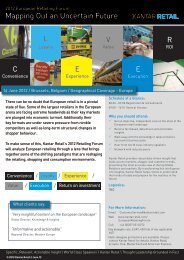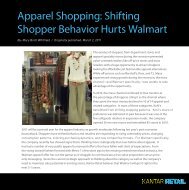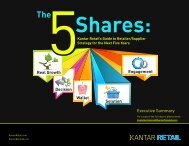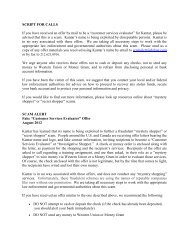The Future Shopper March 2013.pdf - Kantar Retail
The Future Shopper March 2013.pdf - Kantar Retail
The Future Shopper March 2013.pdf - Kantar Retail
Create successful ePaper yourself
Turn your PDF publications into a flip-book with our unique Google optimized e-Paper software.
and eventually close on the<br />
website. People are buying<br />
and shopping and consuming<br />
potentially every waking<br />
moment of the day.” 3<br />
So it is not surprising that<br />
definitions of e-commerce are<br />
getting murkier. <strong>The</strong> Harvard<br />
Business Review asked, in<br />
2011, “Is it e-commerce if the<br />
customer goes to a store, finds<br />
the product is out of stock<br />
and uses an in-store terminal<br />
to have another location<br />
ship it to her home? Or if she<br />
finds a lower price through<br />
her smartphone and orders<br />
it electronically for in-store<br />
pickup?” 4<br />
Who do you trust?<br />
25%<br />
Advertising<br />
70%<br />
Strangers<br />
with product<br />
experience<br />
Source: Edelman Trust Barometer, US consumer survey, 2010<br />
90%<br />
Friends who<br />
have used<br />
the product<br />
As shopping changes, the<br />
shopper’s experience becomes<br />
more complex, and harder for<br />
retailers and brand owners<br />
to manage. Transactional<br />
costs fall in an ‘everywherecommerce’<br />
world, and so do<br />
knowledge and information<br />
costs. Increasingly, it is the<br />
flattening costs of knowledge<br />
and information that are<br />
making the biggest difference<br />
to the shopper.<br />
From the customers’<br />
perspective, they now expect<br />
access to the whole catalog,<br />
not just the range of goods<br />
in a particular location, and<br />
they also expect the retailer<br />
to keep track of their personal<br />
shopping history with that<br />
retailer, regardless of location<br />
or platform. In other words,<br />
the customers want the<br />
retailer to manage their “3<br />
Ps” (profile, personal history<br />
and preferences) and let them<br />
have access to it whenever and<br />
wherever they want it.<br />
From the retailers’ perspective,<br />
they are now in a world<br />
where there are far more<br />
intermediaries than there were<br />
before, making it much harder<br />
to communicate directly<br />
with the shopper. Shopping<br />
decisions are now framed<br />
and managed by aggregators,<br />
deal sites, social media and<br />
social recommendations. <strong>The</strong><br />
speed of this change has been<br />
remarkable. Only a quarter<br />
of Americans believe that<br />
advertising is a credible source<br />
of product information; friends<br />
who have used the product are<br />
mentioned more than three<br />
times more frequently.<br />
But there is an upside here.<br />
Companies that do manage<br />
to make the connection with<br />
their shoppers are rewarded<br />
with permission to have a fuller<br />
relationship than traditional,<br />
mainstream bricks-and-mortar<br />
retailers ever did.<br />
All of this new conversation is<br />
being shaped and enabled by<br />
a surge in personal, portable<br />
digital technologies, mostly<br />
smartphones, but also tablets.<br />
<strong>The</strong>se are already widely used<br />
for shopper R’n’R (research<br />
and recommendation) and<br />
are being used for purchase<br />
4<br />
<strong>The</strong> <strong>Future</strong> <strong>Shopper</strong>












